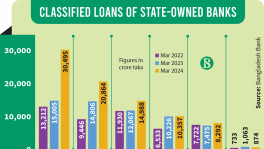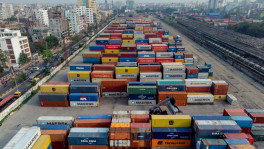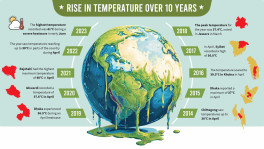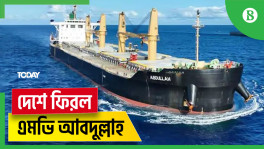Waste should be considered a resource, raw-material
We have to remember that in a circular economy, the system should be designed in such a way that waste from one industry is regarded as a resource for another

The composition of megacity Dhaka's waste has been changing along with economic development and population growth. If you look at the composition of this waste, you will see that the percentage of packaging material in it has increased as well as the percentage of electronic and other hazardous waste. This sort of undisposable waste is creating problems. Previously, 80% of waste was organic.
People in the city dump their domestic waste in places determined by the city corporations, but some dump it in illegal places. Once, the city corporations of Dhaka had the capacity of processing only 40% of its total waste, but their capacity has increased now to around 70%.
There are two parts in waste management – the soft part and hard part. We have to focus on the soft part more because it involves the general public. In this part we have to make them aware about maintaining waste in their homes in proper ways and giving them guidelines according to a rule.
In our country, domestic waste is being handled four to five times in the process of disposing it from a dining table to the landfill. But in developed countries, this process is done in a simple way where waste is transported directly from houses recycling facilities.
If waste separation is improved at the domestic level then it will be easy to recycle. We have some recycling technology which can be useful for doing that, but, if the waste is mixed from the beginning and not separated properly then it will be hard to use it.
In our country, we still have not implemented the urban waste management handling regulation, on which we have been working with the government since 2005. Currently, the draft regulation is in the law department.
Our neighbouring countries, like India, have these kinds of rules and regulations which are very handy in waste management. But the present state of waste management is rudimentary – where the main focus of the municipalities is to collect waste and dump it in landfills.
In a megacity like Dhaka there are different kinds of waste including biochemical waste, infectious and toxic waste. If this waste is mixed and kept in a place for a long time, it produces a black toxic liquid which can spread in surface water and groundwater and cause a serious threat to the environment and human health. If all waste management is done in a controlled and scientific way then it can be possible to avoid these kinds of risks.
There is no effective waste management system in other cities of the country, either. As most of these cities are small in size and have a small population the problem of waste management is not as severe. But, we need to undertake policies for the future because the rapid economic growth will also bring us to face challenges concerning waste management in these cities.
We have to come out of the concept of landfills in such a small country like Bangladesh where around 30,000 tonnes of waste are produced in the urban areas of the country per day. According to the World Bank, the amount will be 67,000 tonnes in 2025. So, if we do not incorporate the concept of reducing waste, the amount of waste will increase and more landfills will be needed. Landfills should be created with such facilities that around 70% of the waste can be reused.
If we look at the waste composition in our country, we would see that most of the waste is harmless domestic waste. But recently, the Covid-19 pandemic has posed a threat of hazardous waste at the domestic level. Then there is: institutional waste, market waste, healthcare facilities' waste, and hazardous waste. But, in our country, there is no separate system to maintain hazardous waste. It is hard for the government to do all the work alone, so initiatives should be undertaken with Public Private Partnership in this regard.
The modern perspective about waste management is that we should consider waste a raw material. Different kinds of waste can be used as raw material to produce fertiliser. The government spends a lot of money on chemical fertiliser but if it could recycle waste for that purpose it would save a lot of public funds. Around 10% of the 6,500 tonnes of waste collected from the two city corporations in Dhaka is plastic waste. Only 10% of this plastic is recycled.
If you look closely, you will find that Bangladesh is the perfect place to transform organic waste to fertiliser because of its climate which works as a natural reactor decomposing waste. But in many countries, they need separate reactors which control temperature to decompose organic wastes.

To manage the whole process, the government has to make a mega detailed plan along with the city corporations, outlining a clear policy and guidelines for the parties concerned. The city corporations will not be able to implement everything alone, they will need a national level guideline.
The involvement of the private sector, the involvement of the general public and communities also should be illustrated. The waste collection and transportation process should be smoothened and here we will need the involvement of people at the community level.
We need to abolish the term landfill; instead, we have to use a resource recovery facility where 10% of the waste will go to the landfill in a controlled way and the rest of the waste will be recycled. This recycled waste could be used to produce valuable products.
Even human waste is a good source of different elements which can be used in agriculture and other sectors. A project has been implemented in Kushtia regarding this for which the mayor of that city has been awarded.
Changes have been made gradually at the policy level in recent years. Once, the Asian Development Bank (ADB) and the World Bank gave loans to the government for waste management and the government used that money to buy vehicles and create landfills. But now, the agencies put specific terms of recycling and other means while giving loans for this sector.
Illegal landfills in and around Dhaka city, where people dump waste, are a concern for both the environment and human health. To stop such illegal landfills, mostly in canals and water bodies, we have to implement anti-littering measures. But before we take action, alternative waste management systems in those places must be developed and awareness programmes must be implemented among the local people.
Recently, we have identified the points, via GPS, where these illegal landfills hotspots have been created. The city corporations can use that mapping to work on these landfills.
According to the World Health Organization, more than 40 diseases can be caused due waste pollution including skin disease and cancer. There is also a risk of plague which has already happened in India's Surat due to waste pollution, so we have to be conscious and take precautionary measures.
The most vulnerable groups to be exposed to such diseases are the people who are directly involved in the recycling business, who work in the recycling industries and those who collect waste for the city corporations.
Medium and high-income people can also be exposed to such disease through the persons from the family members of these people because they work as house workers in different areas of the city. So, everybody in the society is at risk – whatever class you belong to, it does not matter.
Another major risk factor of waste pollution is soil pollution through which the toxic chemicals can enter the food chain. In water bodies, different aquatic living organisms, including fish, can be affected by this.
We need a one window solution under all the concerned government and non-governmental institutions including local governments, the Ministry of Industry, Ministry of Health, Ministry of Planning, etc. The city corporations should be engaged in the process. People from all social spectrums, including politicians, should be involved here; it could be a political agenda to make their respective ward or locality green.
We need to reuse a landfill many times as it will not be possible to maintain waste in the city because the Matuail landfill is already full. The city corporation is searching for another site to dump waste. We need integrated landfill sites to recycle different waste – like in The Netherlands. In this regard there could be private investments here and thus the pressure on the city corporations could be reduced.
However, the main focus of the waste management should be on making the community aware about the proper maintenance procedure of waste. The illegally-grabbed canals of the cities should be rescued and that will improve the situation. Different private sectors can source their raw materials from properly managed waste. There is a huge demand for plastic waste or other heavy waste like aluminum, etc.
If the government provides subsidies for private investors from the policy level, to invest in the waste management sector, it will reduce costs. It would make a good contribution to the country's economy. Foreign technology providers can also work in this regard along with local partners here.
We are working on creating a roadmap concerning plastic waste, now, and trying to identify the places where the most plastic waste is being dumped. We are seeking ways to stop this sort of dumping and thinking about alternative options.
We need to create recycling facilities for this roadmap. We want to make the producers of waste contribute according to Extended Producer Responsibility (EPR) including big companies like: Nestle, Coca-Cola, Unilever, etc. The authorities are thinking about a new law concerning EPR which would make these companies responsible for contributing to the waste management sector, especially the waste they produce.
There is a national policy named the RRR Strategy [Reduce, Reuse and Recycle] which was started by the government in 2010. Several projects were undertaken according to this strategy – like reducing greenhouse gas emissions from the waste. If we process our organic waste properly, greenhouse gas emissions will be reduced – which is also a goal of the Sustainable Development Goals.
Industries have also been prescribed to stop using multi-layer packaging material, like plastic bottles or mini packs, which users dump everywhere. So, a lot of work has to be done upstream from the production level, where some changes should be made in packaging design.
We have to remember that in a circular economy, the system should be designed in such a way that waste from one industry is regarded as a resource for another.
Abu Hasnat Md Maqsood Sinha is a co-founder of Waste Concern


 Keep updated, follow The Business Standard's Google news channel
Keep updated, follow The Business Standard's Google news channel
















